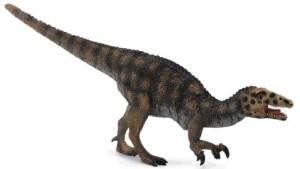Winton Formation Yields New Dinosaur Species
Western Queensland is once again vying for the attention of palaeontologists with the announcement of the discovery of three new dinosaur species, one theropod and two titanosaurs. The fossil remains were discovered near the town of Winton, an area that is rapidly becoming a hot spot for Cretaceous dinosaur fossils with a number of exciting discoveries over the last few years.
Three New Dinosaur Species
The town of Winton and the surrounding Mesozoic strata has become the hub of activity for a number of research teams as they strive to unlock secrets about the southern continent’s prehistoric past. Winton and the Winton Formation has gained a reputation as being one of the best places to go to in the world to find new dinosaurs.
To read an article about the work going on in Winton: Putting Australia on the Palaeontology Map.
To date something like 400 individual dinosaur bones have been removed from the various dig sites, the report on the three new types of dinosaur has been published in the online scientific journal PLoS One (Public Library of Science One). The scientists claim that the theropod discovered is a member of the Allosauridae and may be a relative of the meat-eating dinosaur known as Neovenator, the remains of which have been found on the Isle of Wight.
A New Theropod Dinosaur
This new allosaur has been named Australovenator wintonensis. It would have stood over two metres tall on its strong hind legs, and with three, large claws on each powerful hand, this dinosaur would have been a speedy and formidable hunter. The fossils have been dated to approximately 98 million years ago, to the mid Cretaceous (Albian faunal stage), when Australia was much nearer the south pole than it is today. The fossils of Australovenator are the most complete meat-eating dinosaur fossils found to date on the continent.
When compared to other land masses, the dinosaur fossil record for Australia is quite sparse, scientists are working hard to “plug the gaps” in their knowledge of Australian dinosaurs as this work will help researchers understand the geographic distribution of certain dinosaur groups and their taxonomic relationships.
Titanosaur Fossils
The fossil site was discovered in 2006 when a single bone was found, after extensive excavation a large amount of fossil material has been unearthed, including this new allosaurid and two new types of titanosaur. The dinosaurs were nick-named during the excavation and preparation process, a common occurrence in palaeontology. The Australian song, Waltzing Matilda was composed in the town of Winton in the late 19th Century, so these new dinosaurs acquired nicknames from characters featured in the song.
The ferocious Australovenator was named “Banjo”, the two titanosaurs Diamantinasaurus matildae was called “Matilda” and the second more gracile titanosaur with a longer neck, Wintonotitan wattsi was christened “Clancy”. The fossils of meat-eating “Banjo” and the herbivore “Matilda” were found in close proximity. The sediment from which these fossils were removed indicate that this was a lake or to give it a more Australian term a billabong, when these animals met their end.
Images show a scale drawing of the three new types of dinosaurs. The stocky titanosaur Diamantinasaurus, the larger, although more slender Wintonotitan and the medium sized allosaurid Australovenator.
Perhaps the large herbivore got stuck in the mud and the theropod was attracted to the site in the hope of getting an easy meal but became stuck itself. Several of these sites, called predator traps have been found in the fossil record.
A team of palaeontologists from Queensland Museum led the excavation, one of the scientists, Scott Hocknull commented on the discovery of the allosaurid theropod stating:
“It [Australovenator] was the cheetah of its time, light and agile. It could run down most prey with ease over open ground “.
He went onto say how important these new finds were, and how as a result of the new discoveries, Australia was firmly on the “palaeontology map”.
A Model of the Australian theropod dinosaur Australovenator
The picture (above) shows a model of the Australian theropod dinosaur Australovenator. This model is part of the CollectA Age of Dinosaurs Prehistoric Life series: CollectA Age of Dinosaurs Prehistoric Life Models.
Professor Rod Wells from the School of Biological Sciences at Flinders University, South Australia, added:
“Australia is the exciting new frontier in vertebrate palaeontology. Scott Hocknull and his team have opened a new window on the dinosaur fauna of a 110 million-year-old portion of the world that remains largely unexplored, indeed a unique Australian fossil heritage”.
The announcement of the discovery was made at the Australian Age of Dinosaurs Museum in Winton, Queensland. Scientists expect to find many more dinosaurs and other prehistoric animal remains in the area, helping to build up a picture of the ancient Australian outback.







Leave A Comment